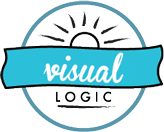You’ve invested a lot in having the right people in the room: the presenters, the venue, travel, lodging, and everyone’s valuable time.
What will they remember two weeks from now? Two months from now? Will they act on it?
No one likes meeting minutes and people rarely consult their notes, if they made any and can find them. They’re even less likely to look at slide decks and no one has time to watch videos. So how can you ensure they remember?
Increase impact and learning in the moment, and reinforce it later.
Graphic Recording DOES BOTH!
Four reasons are laid out in Richard E. Mayer’s 12 Principles of Multimedia Learning*:
1. Coherence Principle – People learn better when extraneous words, pictures and sounds are excluded rather than included.
A skilled Graphic Recorder uses images and symbols that relate directly to the content and will enhance understanding and recollection. There’s nothing random or extraneous. Furthermore, by selecting only the key words or phrases that best communicate the idea, the Graphic Recorder also eliminates extra verbiage, increasing focus on the main concept.
2. Signaling Principle – People learn better when cues that highlight the organization of the essential material are added.
The Graphic Recorder will emphasize key words and ideas using color, image, and other techniques, and will also highlight related concepts and patterns with color, bounding boxes or circles, etc. or may connect them with arrows.
3. Spatial Contiguity Principle – People learn better when corresponding words and pictures are presented near rather than far from each other on the page or screen.
Words and their related images are naturally co-located on graphic recordings, and many Graphic Recorders also utilize a concept called the “graphic sandwich” that incorporates word and image into one unit.
4. Multimedia Principle – People learn better from words and pictures than from words alone.
Words alone are processed primarily in the verbal centers of the brain, while color, pattern and image are processed in a number of areas. Together, they create a rich tapestry of memory that is both more accessible and more detailed than words alone. Color and image can even help capture the feelings (passion, commitment) that were present when the graphic recording was being created.
And that’s just in the moment.
There’s tremendous value to be derived from the graphic recording after it’s created:
5. Following a presentation or meeting session, people find that viewing the finished graphic helps them process what they’ve heard—increasing understanding and allowing them to literally connect the dots.
(Over the years, I’ve had many people tell me they didn’t “get it” until they looked at the graphic afterward.) Graphic recordings do this much more effectively than flip charts or powerpoint slides, because they pull everything together in one place and time. That last is yet another of Mayer’s Principles.
When a whole day’s graphic charts are displayed around the room, it’s a powerful indication of how much people have learned and done, and a tour of the walls is a great way to start off the next day.
6. Short term memories become long-term memories when the digital version of the finished graphic recording is received a week or two later.
Because the graphic is engaging and literally “attractive”, people are drawn to look at it again. Think of it as an illustrated executive summary.
No matter where they enter into it, people quickly become involved in looking at the whole thing, and in only a 3 or 4 minutes can recall everything of importance that happened during the session. This makes the graphic useful in many ways:
–Creating lasting, long-term memories
–Sharing with others
–Kicking off the next meeting with a review of the chart
–Referring to later to remember
–Knowing where in the slide deck to look for detailed information
Taken together, these 6 Reasons make Graphic Recording a powerful tool to add to your meeting repertoire, and go far beyond the “Wow factor” to create lasting impact from high-value events. The added value accrues to both the meeting sponsor or organizer and to participants too, making the investment in graphic recording quite reasonable on a per-participant basis.
For more information on how to bring the magic of graphic recording to your next meeting, let’s talk!
*Source: Multimedia Learning by Richard E Mayer


Recent Comments